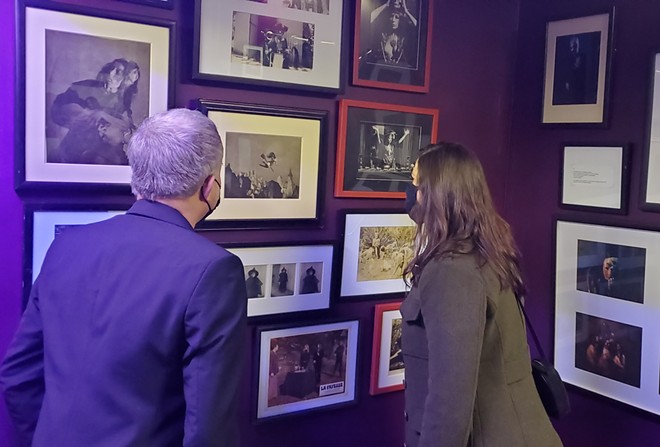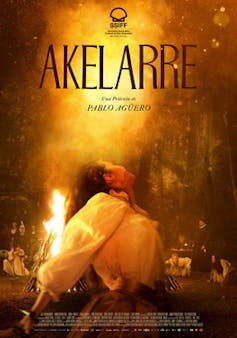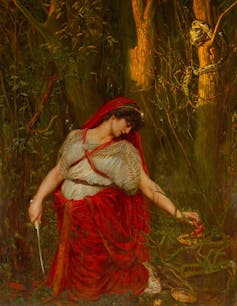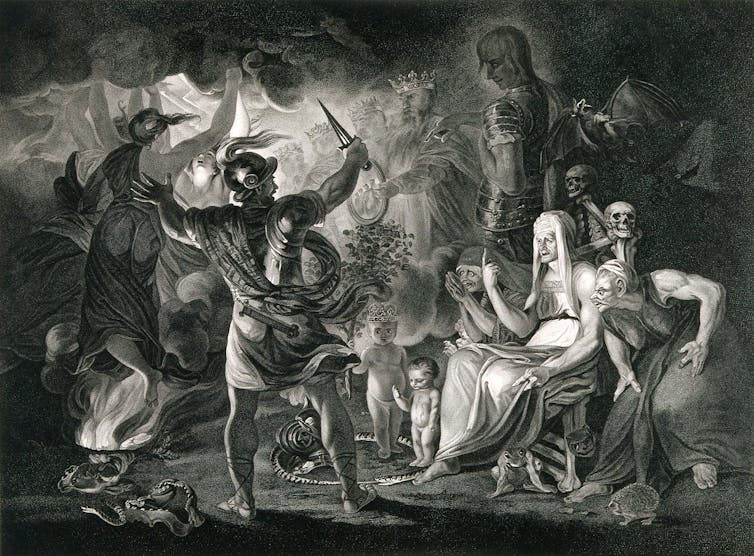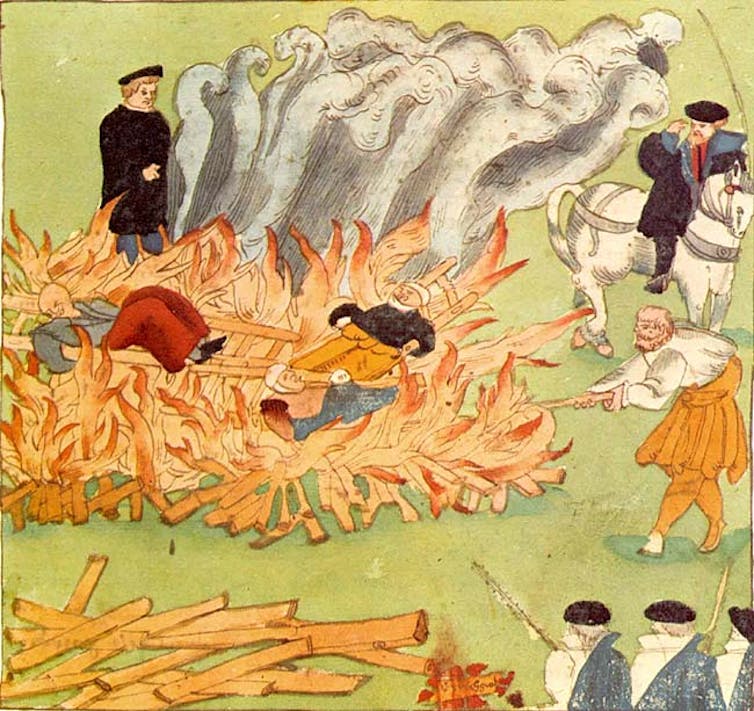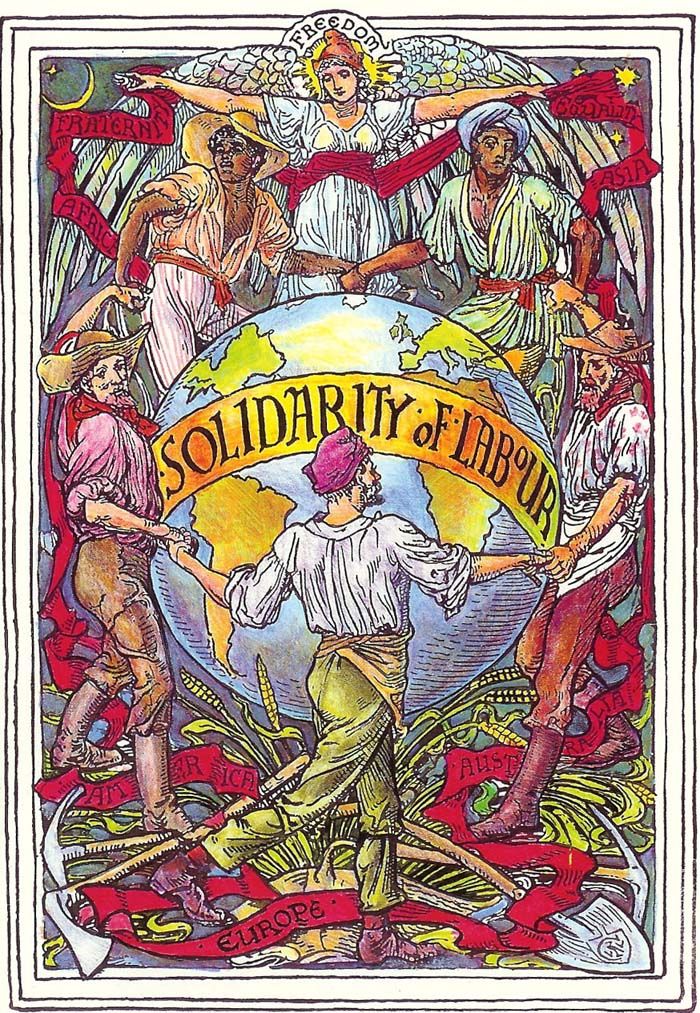
“Religion is the sigh of the oppressed creature, the heart of a heartless world, and the soul of soulless conditions. It is the opium of the people…”
“Criticism has plucked the imaginary flowers on the chain not in order that man shall continue to bear that chain without fantasy or consolation, but so that he shall throw off the chain and pluck the living flower.” — Karl Marx
Cynical Attacks by Marxists About Neopaganism
“Neopagan Marxists? What are you talking about? We Marxists are atheist materialists. We don’t believe in any gods. Do you remember what Marx said about religion? It is the opium of the people. Why are you bringing superstition back in? Neopaganism is just more decadent 1970s hippie romanticism calling for the return to a preindustrial age. All this Goddess crap is just the lunatic fringe of the women’s movement trying to bring religion back in. Real socialist feminists are atheists. If anything, Christianity was a moral advance over the barbaric paganism of the Bronze and Iron Ages.” Serious charges indeed to be answered throughout this article.
Demanding Workers be Atheists Alienates Marxists from their Base
One of many problems for Marxists in the West is that most people in the working class believe in God, whether they are Protestants, Catholics, Jews or Muslims. Furthermore, whether Marxists like it or not, most people around the world find religious rituals enjoyable, comforting and meaningful. If people treat rituals in a mindless, reified way, that does not mean rituals can be dismissed. In addition, rituals have power not just in religion, but in nationalism and sports which have drawn from religion. Typically, Marxists dismiss religion, nationalism and sports as deriving from false consciousness, simplistic reasoning of the workers or evil machinations of priests or rulers. But this has not stopped working-class people from continuing to be faithful to their religion, country and sports teams. Do you Marxists really want to continue to throw stones at the buildings of churches, stadiums or the bronze cast statues of famous nationalistic generals?
The Structure and Superstructure of Societies
Using a Marxist delineation of social structures, both capitalist and socialist societies have an infrastructure and superstructure. The infrastructure includes the economy technology, methods of harnessing energy and work patterns. The superstructure of society includes the knowledge systems including politics, law, philosophy, art, religion and recreational patterns. Broadly speaking, superstructural institutions supportthe existing order for better or worse. More specifically, under capitalism these include religious monotheism, nationalism and professional sports.
The Superstructural Mainstream Institutions of Religion, Nationalism and Sports and their Commonalities
Religious monotheism, with all its material configurations (churches, altars, pews) is comprised of social-psychological techniques (sin, confession, guilt) and paraphernalia (rosary beads, crosses on necks) was also used by nationalists to get people to bind themselves to the state politically. Sports helped to organize people’s loyalty in their leisure time to a sports team. Religion, nationalism and sports all have many commonalties:
- A mythology of origins and destiny
- A founder
- A set of rites the community engages in
- Special holy days and holidays throughout the year
- A place to go for pilgrimages
- A set of buildings – temple, stadium to enact these rituals
- A set of holy objects
- A cultivated songbook of inspiring music
- Very specific set of rules to follow
- A holy book
- A definite attitude to other groups
- Emotional expectations
- Heretics
- Scapegoats
- Specialized language
- Sacred arts
- Methods of altering states of consciousness
- Attitudes towards the senses
- Collective memories – what you remember; what you forget
Monotheism, nationalism and sports are mainstream superstructural institutions of capitalism that are directed mostly atthe working-class. These institutions both alienate them from their social needs while providing them with inspiration, comfort, solace and hope. At the same time, there are superstructural capitalist movements which offer hope not only to working class people but to middle class and upper middle class people.
The Social and Psychological Aims of Capitalism vs the Hopes and Desires of the People
In order to derive maximal profit, the capitalist structure must pulverize social life so that every social and psychological need and desire is for sale. It must also create a consumer individuality so that the person is preoccupied with building and sustaining their individuality through consuming capitalist products. Naturally enough, many people who live in a capitalist society want to get away from this. Some of them flee into the capitalist superstructural institutions such as monotheism, nationalism or sports as a way to:
- Creating an ideal community
- Experience altered state of consciousness
- Develop an individuality that is larger, wider and deeper than what consumer individuality has to offer
Superstructural Movements: Human Potential, New Age and Neopaganism
But the working class is not the only class which seeks another way of life from what capitalism has to offer. The Human Potential movement in the 1970s was an attempt by mostly middle-class people to create alternative communities, to experience altered states of consciousness and cultivate a new individualist identity. So too, in the late 1970s the New Age movement wished to the same thing for the upper middle classes. These included spiritual, political and psychological cults, the paranormal movement (interest in ESP, telepathy, extraterrestrial civilizations) and Eastern mysticism (mediation, yoga) Lastly, also in the late 1970s Neopaganism exploded in both the United States and England.
Unlike monotheism, nationalism, sports and interest in cults, the New Age and Neopaganism are attempts to break awayfrom what seems to be to be the collapse of western religious institutions. What these movements promise the individual is to be swept away from everyday life to an alternative community, radically altered states and an individuality which is not submissive to a god, state or sports team but something higher, deeper and richer. To summarize, there are two components in the capitalist superstructure:
- Mainstream institutions: religion, nationalism and sports – which support capitalism
- Movements: the Human Potential Movement, the New Age movement and Neopaganism which seek to break away from capitalism or at least its corporate version
What both superstructural institutions and movements all seek to create is:
- An ideal community
- Experiencing altered state of consciousness
- Developing an individuality that is larger, far more so than what consumer individuality has to offer
Socialist Infrastructure and Socialist Superstructure
At its best, the socialist infrastructure has an economy that is communist, with workers’ councils deciding what and how much to produce at the local level, federated at the regional level and centralized at the state level. There is advanced technology. The socialist superstructure consists of a materialist philosophy, is pro-science and pro-technology and practices political direct democracy. There is also socialist art and there is atheism.
Socialist Rejection of Capitalist Superstructure
Good reasons for rejection
There are the atheists, socialists, communists and anarchists who think that religion, nationalism and sports are intentional distractions concocted by the ruling class to keep the working class from collectively changing life on earth. Further, the search for paranormal or mystical experience will be understood by Marxists as an attempted withdrawal from capitalist institutions in a fruitless search of meaningful experience. Socialists argue that paranormal experience has never been proven by scientists to be repeatable experimentally, while mystical experience is private escape and rarely produces revolutionaries. “Who needs spiritual a superstructure?” Marxists may say. “We see what happens when superstructural institutions are introduced into the capitalist superstructure by way of monotheism, nationalism, sports. People reify their gods, national heroes and sports figures. They engage them superstitiously and religious participants, citizens or sports fans behave submissively or mindlessly and use these institutions as escapes.
Furthermore, the impact of superstructural movements can also be engaged superstitiously and its leaders reified. The eruption of cults, psychic research and meditation centers produces its share of gurus, groupies and escapism. “Who needs that?” say the Marxists. The problem is that these capitalist superstructural institutions and movements contain 80% of the population (40% working class, 30% middle class and 10% upper middle class).
Bad reasons for rejecting
However, atheistic socialists and communists do not understand that what people who engage in institutions, movements and personal quests also want is not just about what they believe, but what they experience in a ritual-altered state. Arguing with people that science shows the earth is actually a lot older than the bible says is not going to change any fundamentalist’s minds and the evangelical atheists are foolish to try. Attempting to convince nationalists that their country’s crimes are greater than their heroic deeds is like spitting in the wind. Making an effort to convince sports fans that they shouldn’t root for their home team because neither the players nor the owners are loyal to their city will never work. The great weakness of all atheist socialists is that what people believe and the vehicles they use to support their beliefs can’t be argued with because these things all give comfort, hope and community. Communists throw rocks at the churches and stadiums but they are really afraid to go in. What socialists need to do is:
- Understand what people believe and how the rituals work that supports beliefs
- Recreate our own version of the 19 elements I earlier named that religion, nationalism and sports all share
Marxists do not have to Reinvent the Wheel:
The Neopagan Movement can Provide Marxists with a Missing Sacred Superstructure
Enter Neopaganism. At its very best, Neopaganism provides a far more convincing story about the cosmic evolution. It also offers a way to live in a world of conflict without losing heart or enthusiasm. Neopaganism also uses some of the same methodologies as monotheism, nationalism and sports to create altered states of consciousness. It does so relatively successfully and it does not require dogma to do it.
The Neopagan movement can bring life of the sacred into the socialist superstructure in ways that, at their best, are not superstitious, not reified, anti-hierarchical and not escapist. Joining with Neopagans will enable socialist to recruit the population currently embedded in the capitalist superstructure and lure them into a neopagan superstructure that will be in the service of socialism in our fight against capitalism.
Marx’s Criticism of Religion was too Sweeping
Marx rightfully criticized the Catholic and Protestant monotheism as it was practiced by the ruling classes of Europe, but his criticism of monotheism does not cover the polytheism or animism of pagans. In the case of the animism of hunter-gatherers who occupied most of human history, there are a lot of problems with characterizing animism the way Marxism criticized religion in my opening quote. The first animists were politically egalitarian, economically practiced what anthropologist Marshall Sahlins called “generalized reciprocity” and they had no private property. There were no gods and goddesses, just earth spirits, totems and sometimes ancestor spirits. There were no spiritual hierarchies. These earth spirits were treated as humanity’s brothers and sisters. There was no adoration, worship, begging and pleading or faith necessary. The sacred life of hunter-gatherers was no vale of tears, the heart of a heartless world, the soul of a soulless word. The type of magick they practiced was hardly the opium of the people. I am not suggesting socialists return to hunting and gathering times and practice animism. However, the animistic beliefs and practices can be used as a sacred model on which to build a communist future.
Neopagans are Hardly Washed-up Left-over Hippies
According to Margot Alder, in her book Drawing Down the Moon, Neopagans as a group are intelligent, interested in science, creative, imaginative and growing in both the United States and England. They have made inroads into mainstream religious conferences and they have yearly conferences of their own as well as regional celebrations throughout the United States. In fact, in the United States, Neopaganism is the fastest growing “religion”. We Marxists would be very lucky to have them join our ranks.
There is no Contradiction Between Dialectical Materialism and Most Neopagans
Ontologically, I identify as a Neopagan, but this in no way requires me to challenge a materialistic framework. Though some pagans are god and goddess theists, there is a vital community of Atheopagans who are materialists and believe in no gods. While I have a couple of disagreements with Mark Green (author of Atheopaganism: an Earth-honoring path rooted in science), we have enough in common to say that Atheopaganism will answer in a scientific way most, if not all the reservations of Marxists. There are other Neopagans whose goddesses and gods are admitted as psychologicalprojections and have no real independence. This is no threat to dialectical materialism. My criticism of Marxism is an immanentcriticism. It’s that materialism needs to incorporate collective and individual imagination without becoming a vitalist or a pantheist.
Characteristics of Neopaganism
There are at least fourteen characteristics of Neopaganism which have literary roots going back to mid 19thcentury Europe. These characteristics would work very well with Marxism.
- Perception of divinity as immanent (as opposed to transcendent)
- A multiplicity of deities (polytheism) while for a few there is one deity, a single goddess (this is opposed to patriarchal monotheism)
- The deities are female as well as male
- A commitment to ecological responsibility as the most practical way to engage nature
- Appreciation of science, science fiction and technology (as opposed to superstition and luddism
- Creative approach to ritual with singing, dancing, music, drawing, and mask-making
- Emphasis on imagination in guided visualization as essential in creating altered states of consciousness
- Orientated to the tides of nature and circle of the seasons and the four directions
- Devotion to hedonism or the sanctification of pleasure
- A focus on the local places (as opposed to large spaces or beyond space)
- No concept of sin or salvation
- No need of proselytizing
- Sacralization of psychology through Jungian psychology or the sacred psychology of Jean Houston
- Living in the here and now, not seeking escape in heaven or nirvana
 The Neopagan movement in Yankeedom largely came out of the feminist sacred movement, which was also political. Some Neopagans are liberal, but many are radicals. Generally, thanks to Starhawk and Z Budapest, many witches integrate their magickal rituals with political activity. As for Marxism, there might be a smattering of Marxists who were pagans. But for the most part, they were isolated and didn’t constitute any identifiable subgroup within Neopaganism. Then, at the turn of the century, feminist Silvia Federici wrote Caliban and the Witch that brought a feminist understanding to the witch hunts. More recently, about seven years ago, a practicing Marxist Neopagan named Rhyd Wildermuth began a small publishing house called Gods and Radicals. One of his books was All That is Sacred is Profane: A Pagan Guide to Marxism. In this work, Wildermuth tried to make a Marxian understanding of capitalism understandable to pagans. However, he did not try to make Neopaganism attractive to Marxists. That’s what my book is about – The Magickal Enchantment of Materialism.
The Neopagan movement in Yankeedom largely came out of the feminist sacred movement, which was also political. Some Neopagans are liberal, but many are radicals. Generally, thanks to Starhawk and Z Budapest, many witches integrate their magickal rituals with political activity. As for Marxism, there might be a smattering of Marxists who were pagans. But for the most part, they were isolated and didn’t constitute any identifiable subgroup within Neopaganism. Then, at the turn of the century, feminist Silvia Federici wrote Caliban and the Witch that brought a feminist understanding to the witch hunts. More recently, about seven years ago, a practicing Marxist Neopagan named Rhyd Wildermuth began a small publishing house called Gods and Radicals. One of his books was All That is Sacred is Profane: A Pagan Guide to Marxism. In this work, Wildermuth tried to make a Marxian understanding of capitalism understandable to pagans. However, he did not try to make Neopaganism attractive to Marxists. That’s what my book is about – The Magickal Enchantment of Materialism.
What is Sociohistorical Paganism?
Sociohistorical Neopaganism has no inconsistency with the tradition of dialectical materialism. It understands that both nature and society are products of the dialectical forces of Darwinian natural selection, combined with chance and – with the emergence of the human species – teleonomy (the internal planning of the human species). It also understands human society as an evolving process riddled with class contradiction tensions between the structure and superstructure of society which result in qualitative leaps in political organization and economic systems. It accepts uncertainty as a way of life. Opposites are understood as polar. Because of the conflict between opposites, a new higher emergent synthesis comes about historically, socially and psychologically
Sociohistorical Neopaganism is inclusive of all socialist groups, and welcomes dialogue with Atheopagans, soft and hard polytheists, as well as Evangelical atheists (of which hardline Marxists are one type). The similarities and differences between evangelical atheists, Atheopagans, soft and hard polytheists is the subject of the first chapter of my book.
We respect the process philosophy of Whitehead, Hartshorne, and David Ray Griffin in their attempt to argue that there is an internality in nature all the way down. This does not make us panpsychists since we believe there is an internality (what Whitehead called prehensions) long before there was any consciousness in nature. We believe with Engels that there is a dialectic in nature that goes all the way back to subatomic particles, and that evolution must be understood as a spiral with ever-new emergent properties emerging from conflict. Western humanity’s conception of heaven and hell are sociological projection of alienated humanity. When and if socialism becomes predominant in the world, it will approximate heaven on earth. This will go a long way towards dissolving infantile notions of heaven as a place to be taken care of or a hell as a place to suffer.
Unlike all other groups, sociohistorical pagans are committed to discovering a fifth stage of cognitive development beyond Piaget’s formal operations. Originally called “dialectical operations” by Klaus F. Riegal, preliminary work has been done by Michael Basseches Dialectical Thinking in Adult Development and Otto Laske Dialectical Thinking for Integral Leaders. A fifth stage of cognitive development will be necessary to synthesize Marxism and Neopaganism in creating a socialist future.
Sociohistorical Neopagans have big plans for rituals. Following the lead of Starhawk and Z Budapest, sociohistorical paganism wishes to incorporate ritual, not only into specific protests and strikes, but also into an ongoing political practice. In addition, we attempt to do once again what the French revolutionaries did: change calendars and populate them with socialist holidays, socialist birthdays, pilgrimages, and rites of passage. We want to bring theatrical practice and collective imagination to socialism.
Unlike so many hardline Marxists, we want to live completely in the present. We believe that the choice for anyone joining us is not made as a result of guilt or morality, but simply that as people we are irresistible. People want to be like us and want to be part of what we are cooking up. For us, altered states of consciousness in a magical ritual is not some kind of monolithic experience of all members. Different social classes will have different altered states because of their class position. Rituals producing altered states will be opportunities to work through some of the class conflicts between working class, middle class, and upper middle class participants.
Unlike any other Neopagan group, our perception of reality will depend on the kind of society we come from and the point in history we which we live. As I have said in a previous book, From Earthspirits to Sky Gods the primitive magic-mythology in tribal societies will be very different from the secondary magic of agricultural states. The difference between the high magic of Renaissance Italy is very different from the low magic of witchcraft, as you will see in Chapter 21 of my book.
Neopagan Marxists work with other pagans’ gods and goddesses psychologically and sociologically, even though for us, these gods and goddesses are not ontologically real. Ghosts, ancestor spirits, and earth spirits can be claimed by Atheopagans and Jungians to be psychological projections. For us they are also sociological and historical projections of human social life and the differences between classes. The characteristics of gods and goddesses – that they all have strengths and weaknesses – are projections that are worth working with but with the understanding that there is a danger of reification. Humanity can have gods, but the gods cannot have us. The characteristics of the gods and goddesses, their identification as departments of life, should be worked in as part of our socialist plans. For example, rituals to the god Hermes could accompany socialist transportation meeting plans. Rituals to Demeter, the goddess of agriculture, accompany the meetings of socialist farmers.
We agree with hardline Marxists that consciousness cannot be reduced to the brain, but we disagree with some other pagans that consciousness is rooted in nature or in a spiritual world. After the existence of the brain and a central nervous system, consciousness arises (as in bonobos and chimps) as the result of toolmaking, social life, and culture that is the inheritance of social animals. However, self-reflective consciousness is the result of the development of a sociohistorical envelope wrapped around the Earth over the biosphere, which Vernadsky and Chardin called the noosphere. Self-reflective consciousness is rooted in sociohistorical activity in creating and sustaining the noosphere.
Lastly, historical sacred oppression is very important to us. Like Neopagan feminist witches, we don’t forget nor forgive what Christianity did during the witch hunts. Neither do we forget nor forgive what the Christians did to the Alexandrian library and how the Church terrorized the likes of Bruno, Galileo and Spinoza. We reject any reconciliation with Protestants, Catholics, Jews and the whole patriarchal 5000-year albatross. Neither are we seduced by Eastern mysticism, whether it be Hindu or Buddhist, cousins of the Western patriarchal family. As a feminist titled one of her plays many years ago, Your 5000 Years Are Up. As sociohistorical Neopagans, we neither forgive nor forget. We will treat the rulers of patriarchy with the same sacred hatred that we treat the capitalists in the secular world. Far from being an advance in sacred life, as many traditional Marxists think, Christianity is a slave religion, a degeneration of a once vital pagan love of life.
What is Magick and What’s With the “k”?
The word “magic” means many things to many people. The technical breakdown of the word is to shape or make vigorous. In this book magic is not a) a secular art of creating perceptual illusions as in stage magic. Neither is it a literal individual and group technique that can directly impact physical reality. What I am calling magickal is a socio-psychological technique for altering individual and group consciousness through ritual by saturating the senses through the arts of singing, dancing, and the use of guided visualization. At its best there is nothing superstitious, reified or escapist in this. As I describe in my book, The Magickal Enchantment of Materialism it can be a guide towards group and individual evolution.
Genesis of this Book
This book really snuck up on me. Over the last five years I have been writing articles for our website, Socialist Planning Beyond Capitalism. In some of these articles I pointed out how religion, nationalism and sports were very big for working class people, but that Marxists had failed miserably to understand what the appeal was, let alone what socialists could do about it. In later articles, I identified rituals, the non-superstitious use of symbols and making of talismans as tools for creating, socialist altered states of consciousness. It wasn’t until the past 15 months that I realized I had written enough articles that I could turn them into a book. Furthermore, I realized that I could add four chapters about magick from my previous books. One chapter is on the place and misplace of goddesses in the Stone and Metal ages. Another chapter is on the differences between primitive magic, secondary magic and religion that was also part of my book Power in Eden. Finally, I included a discussion of high magic in early modern Europe. One chapter was on Renaissance magick as seen through the eyes of Jungian James Hillman. The other chapter was how the Protestant religion, mechanistic science and commercial capitalism teamed up against the high magick of Paracelsus, Bruno, John Dee and the low magick of witchcraft. Both these chapters came out of my book Forging Promethean Psychology.
My Literary Sources
In this section I only want to draw from the books that have most influenced my thinking about this subject. The first is Starhawk’s book The Spiral Dance which I read in the early 1980s. Next was Margot Adler’s great book Drawing Down the Moon which gave me a historical window into the enchanting world of Neopaganism. Throughout the 1980s I read books by Israel Regardie which were excellent in combining magickal work on the Tree of Life with psychology. He saw magick as applied psychology with nothing supernatural about it. Around 1990 I met Madonna Sophia Compton and read her book Archetypes on the Tree of Life. She taught me how to apply the Tree of Life to actual daily practice to the work on psychological problems. I had my own solitary practice for some time. Since the middle of the 1990s, until about two years ago I turned to other projects. But in 2020, my partner Barbara and I joined the Seattle Atheist Church. One of the board members really wanted to get more ritual into our group. We wound collaborating on a Fall ritual by changing the liturgy and making it more magickal. For me this meant introducing Neopaganism into the Church. This led me to start an Atheopagan book club in which we read Atheopaganism by Mark Green; Godless Paganism, edited by John Halstead and Wakeful World by Emma Restall Orr.
Why I Wrote this Book
The purpose of this book is not to convince Neopagans that Marxism is a worthy enterprise. Neither is it to convince Marxists to become Neopagans and leave Marxism behind. Rather it is to convince Marxists that Neopagan practice might breathe charm, heart, play and inspiration into the political practice of Marxism, by bringing in ritual and the arts.
Usually, Marxists naively lump animism and polytheism with Marx’s criticism of religion. The purpose of this book has been to show why this is a mistake. In my three chapters on socialism and my chapter on The Power of Magic I show how Neopagan rituals can be worked into a Marxist political practice. These changes in ritual are far more likely to bring back working-class people to socialism who have stayed away up until now because Marxism in the United States has no heart or soul.
So long as Marxists dismiss religion, nationalism and sports as merely false consciousness, simplistic reasoning or blind superstition we are left out in the cold. Dismissal has not worked before and it will not work now or in the future. Marxists will continue to be alienated from working class people who are religious and at least somewhat patriotic and enthusiastic about professional sports. Neither will the middle and upper middle class explorers of cults, parapsychology or New Age mysticism be drawn to Marxism.
Red Emma was Right: If I can’t Dance, I don’t Want to be Part of Your Revolution
Marxists need to sing, spiral-dance and celebrate socialism on a weekly, monthly, seasonal and yearly basis. On a regular, weekly basis we could have a “socialist mass” that must answer the same big questions religion asks and answers:
- What are we?
- Where have we been?
- Where are we going?
During these large-scale and small-scale events, we must play and sing to socialist songs from around the world, not just IWW songs. Just as religion has its patron saints, nationalism has its revolutionary heroes and sports has its Hall of Fame. So socialists could regularly commemorate the lives of great socialist leaders, great socialist strikes and revolutionary takeovers of states. Just as religion has its temples, sports has its stadiums and nationalism has its presidential memorials, so Marxists need their own buildings to commemorate, mourn and celebrate the past and anticipate future days of triumph.
The socialist movement is not a night in which all cows are black. Socialism consists of individuals of different classes who have unique lives. Some are red diaper babies and some are new to the movement. In true socialist form, we celebrate the commonalities that all socialists go through from birthdays, coming of age ceremonies to marriages and funerals. During a portion of most socialist rituals, we should acknowledge rites of passage and support people in the milestones of their lives.
To those Marxists who remain cynical I want to remind them that the labor organization of the Knights of Labor in the 19th century had many rituals celebrating the events of the individual life cycle. My article The Mythology, Ritual and Art of Romantic Socialism discusses all this. The image at the heading of this article comes from the social graphic artist Walter Crane who did much work for the Knights of Labor. In addition, the Communist Party in the United States had many cultural institutions such as book clubs, dances and plays that speak to the ritual-like needs of human beings. We have a great deal we could learn from them.FacebookRedditEmail
Bruce Lerro has taught for 25 years as an adjunct college professor of psychology at Golden Gate University, Dominican University and Diablo Valley College in the San Francisco Bay Area. He has applied a Vygotskian socio-historical perspective to his three books found on Amazon. He is a co-founder, organizer and writer for Socialist Planning Beyond Capitalism.
Read other articles by Bruce, or
visit Bruce's website.


